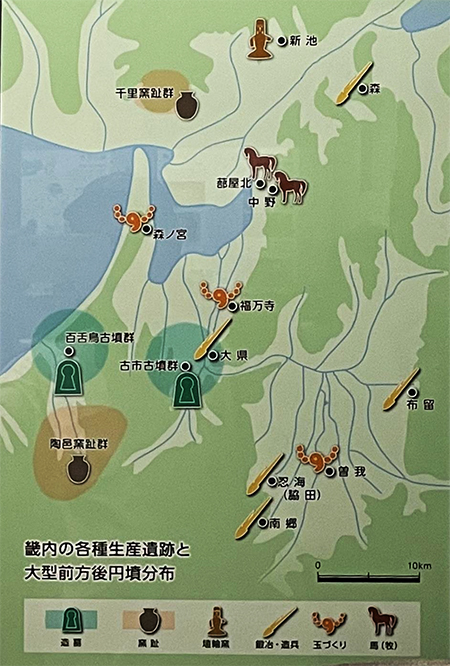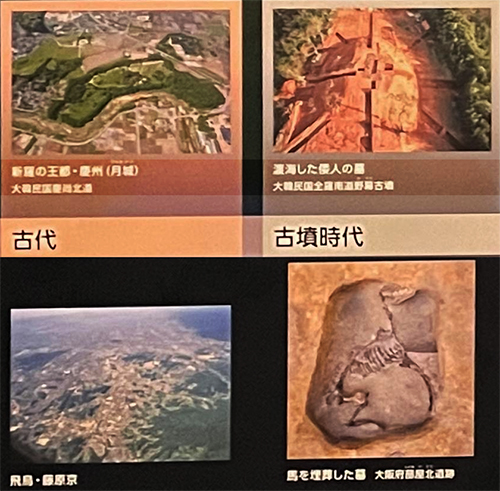
国立歴史民俗博物館の「古代史」展示ゾーンでの知的興奮体験。
いま書き進めているのはこの体験に添って列島史の再学習と思っています。
昔人を知ることで現代の生きる知恵も湧いてくる。
とくに中国社会からは多くの影響を受けて日本社会は創られてきた。
いま、日本人は古代から続く大陸・半島との「付き合い」を考えさせられている。
経済という側面ではアメリカとまったく同じ対応は取れない。
しかし中国大陸ではかつて大きな変動が繰り返し起こり続けている。
易姓革命ということは今後も起こることを肝に銘じていなければならない。
共産主義という表面はただの表層であって、実質は共産党王朝独裁。
いつそれが易姓されるか、それは繰り返す歴史の必然でしょう。
日本社会は幾多の経緯を経てきたけれど、国体としては和の国。
統一とまとまりを確保し続けてきている。
そのことのひとつの知恵として、日本の王権には姓がない。
易姓革命の根拠をそもそも持たせないという知恵を
数々の政治動乱の結果、日本に亡命した多くのアジアの知識階層が
日本の王権に対して刻印してきた結果だと思えてならない。
日本としてはアジア世界から多くの社会資産を受け継いできたことに踏まえ
地域全体の安定を示していくことが今後、国際的にも求められるだろう。
混乱するアジアの中での最安定社会の責任を果たしていかなければならない。
たぶん21世紀の日本の世界の中での大きな役割でしょう。
そういう視点が歴史を再学習してみたいという内的な動機なのかも。
上の図は日本社会に導入されてきたいろいろな製造業痕跡。
畿内地域における鍛冶・道具や窯跡、労力としての馬産などの分布地図。
水田農耕には灌漑から水田土木まで多様な「土木」改変事業が必然化する。
そのときにまずは「鉄器」が最重要戦略物資であり、
次いでそういう土木工事を支える労力としてウマが活用された。
日本では馬産は畿内地域がいちばん古い時期からの導入地域。
水田農耕という「新技術社会」が瞬く間に日本列島を席巻したことがわかる。
権力機構は必然的にそれに随伴し結果したといえる。



今しも、そもそも中国発の感染症の巨大な猖獗がこの発症地域で勃発している。
昨日の日経新聞では中国総局長を永く努めた論説委員・中沢克二氏の記事。
●「北京コロナ感染70%」の深刻度、習政権に2つの司令部。
現在の状況について内情を知る関係者の興味深い説明の部分があって驚かされた。
「いかなる軍隊でも、情勢不利と判断した場合の撤退の際、全滅を避けるため、
追ってくる敵軍を防ぐいわゆる『しんがり』の部隊を最後尾に置いて逃げる。
ところが今、中国では、何の防御措置もとらないままゼロコロナ政策を放棄し、
全員が逃げる潰走が突然、始まった」
巨大人口国家の混乱は、いつの時代でも周辺国に影響を及ぼす。
そういえば日本の世論を動かそうとする「五毛党」などの活動も
最近、やや大人しくなっているように思う。混乱の根は深いのではないか。
English version⬇
Ancient History of International Exchange and Social Development 37,000 Years of the Japanese Archipelago – 49
Japan, which inherited intellectual assets from continental and peninsular societies and created a stable society, has a role to play in showing the wisdom of peace and stability in Asia. …
An intellectually exciting experience at the “Ancient History” exhibit zone of the National Museum of Japanese History.
What I am writing now is a re-learning of the history of the archipelago to accompany this experience.
Knowing the people of the past will give us the wisdom to live in the present.
In particular, Japanese society has been influenced by Chinese society in many ways.
Now, Japanese people are forced to think about their “relationship” with the continent and peninsula, which has continued since ancient times.
In terms of economics, the Japanese cannot respond in exactly the same way as the Americans.
However, in the past, major changes have repeatedly occurred on the Chinese mainland.
We must keep in mind that the “Yi Simei Revolution” will happen again in the future.
The surface of communism is just a surface, but the reality is the dictatorship of the Communist Party dynasty.
Whenever it will be revived, it will be the inevitability of history repeating itself.
Japanese society has been through many vicissitudes, but as a nation, it is a country of harmony.
It has continued to ensure unity and cohesion.
One of the wisdom of this is that Japanese kingship has no family name.
The wisdom of not having the basis for a family name revolution in the first place.
As a result of numerous political upheavals, many Asian intellectuals who defected to Japan
This is the result of the imprint of many Asian intellectuals who defected to Japan as a result of the many political upheavals in the region.
Japan has inherited many social assets from the Asian world.
Japan will be internationally called upon to demonstrate stability in the region as a whole.
Japan must fulfill its responsibility as the most stable society in a confusing Asian region.
Perhaps this is Japan’s major role in the world in the 21st century.
Perhaps such a perspective is the internal motivation for wanting to relearn history.
The figure above shows the traces of various manufacturing industries introduced into Japanese society.
It is a map of the distribution of blacksmithing, tools, kiln sites, and horse production as a form of labor in the Kinai region.
Paddy field agriculture necessitated various “civil engineering” projects ranging from irrigation to paddy field engineering.
At that time, iron tools were the most important strategic commodity.
Next, horses were used as labor to support such civil engineering projects.
In Japan, the Kinai region was the earliest area to introduce horse production.
It is evident that the “new technology society” of paddy field agriculture quickly swept over the Japanese archipelago.
The power structure inevitably followed suit.
Even now, a huge epidemic of infectious diseases originating in China is breaking out in this region.
In yesterday’s Nikkei Shimbun, editorialist Katsuji Nakazawa, who served as China’s general director for many years, wrote: ● “Beijing Corona Infection 70% Serious, Two Command Posts in Xi Administration.
The article was written by Mr. Katsuji Nakazawa, an editorial writer who had served as China’s General Director for many years.
I was surprised to find an interesting explanation of the current situation from a person with inside knowledge of the situation.
The official explained, “When any army withdraws from a situation it deems unfavorable, it must be prepared to defend itself against pursuing enemy forces in order to avoid total annihilation.
In order to avoid being annihilated, any army, when it withdraws from a situation it judges to be unfavorable, will leave a so-called “shingari” force in the rear to prevent enemy forces from pursuing it.
Now, however, China has abandoned its zero-corona policy without taking any defensive measures.
Suddenly, a crushing run in which everyone flees has begun.”
The turmoil in a megapopulation nation always affects neighboring countries.
Come to think of it, the activities of the “Five-Headed Party,” which tries to sway public opinion in Japan
seems to have become somewhat more mature recently. The roots of the confusion may be deep.
Posted on 12月 22nd, 2022 by 三木 奎吾
Filed under: 日本社会・文化研究, 歴史探訪







コメントを投稿
「※誹謗中傷や、悪意のある書き込み、営利目的などのコメントを防ぐために、投稿された全てのコメントは一時的に保留されますのでご了承ください。」
You must be logged in to post a comment.